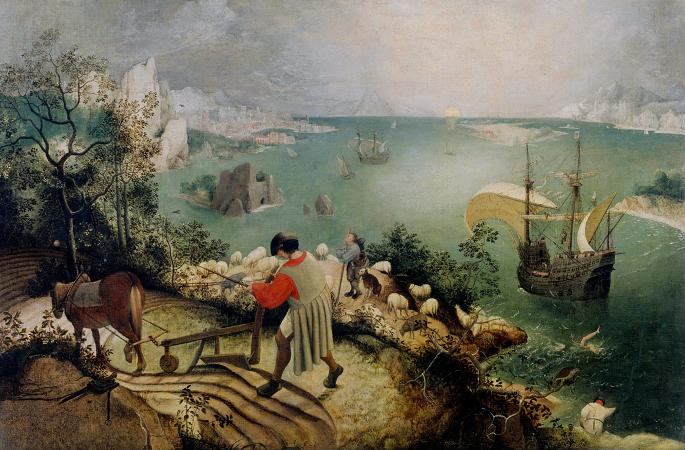
Landscape with Fall of Icarus. Landscape with the Fall of Icarus is a painting in oil on canvas measuring 73.5 by 112 centimetres in the Royal Museums of Fine Arts of Belgium in Brussels.
It was long thought to be by the leading painter of Dutch and Flemish Renaissance painting, Pieter Bruegel the Elder. However, following technical examinations in 1996 of the painting hanging in the Brussels museum, that attribution is regarded as very doubtful, and the painting, perhaps painted in the 1560s, is now usually seen as a good early copy by an unknown artist of Bruegel's lost original, perhaps from about 1558.
According to the museum: It is doubtful the execution is by Bruegel the Elder, but the composition can be said with certainty to be his, although recent technical research has re-opened the question. Largely derived from Ovid, the painting is described in W. H. Auden's famous poem Musée des Beaux-Arts, named after the museum in Brussels which holds the painting, and became the subject of a poem of the same name by William Carlos Williams, as well as Lines on Bruegel's 'Icarus' by Michael Hamburger.
In Greek mythology, Icarus succeeded in flying, with wings made by his father Daedalus, using feathers secured with bees wax. Ignoring his father's warnings, Icarus chose to fly too close to the sun, melting the wax, and fell into the sea and drowned.
His legs can be seen in the water just below the ship. The su
It was long thought to be by the leading painter of Dutch and Flemish Renaissance painting, Pieter Bruegel the Elder. However, following technical examinations in 1996 of the painting hanging in the Brussels museum, that attribution is regarded as very doubtful, and the painting, perhaps painted in the 1560s, is now usually seen as a good early copy by an unknown artist of Bruegel's lost original, perhaps from about 1558.
According to the museum: It is doubtful the execution is by Bruegel the Elder, but the composition can be said with certainty to be his, although recent technical research has re-opened the question. Largely derived from Ovid, the painting is described in W. H. Auden's famous poem Musée des Beaux-Arts, named after the museum in Brussels which holds the painting, and became the subject of a poem of the same name by William Carlos Williams, as well as Lines on Bruegel's 'Icarus' by Michael Hamburger.
In Greek mythology, Icarus succeeded in flying, with wings made by his father Daedalus, using feathers secured with bees wax. Ignoring his father's warnings, Icarus chose to fly too close to the sun, melting the wax, and fell into the sea and drowned.
His legs can be seen in the water just below the ship. The su
Wikipedia ...